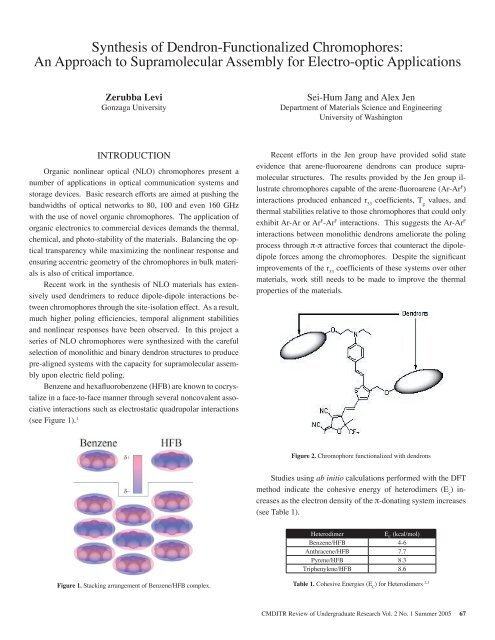Student Project Abstracts 2005 - Pluto - University of Washington
Student Project Abstracts 2005 - Pluto - University of Washington
Student Project Abstracts 2005 - Pluto - University of Washington
You also want an ePaper? Increase the reach of your titles
YUMPU automatically turns print PDFs into web optimized ePapers that Google loves.
Synthesis <strong>of</strong> Dendron-Functionalized Chromophores:An Approach to Supramolecular Assembly for Electro-optic ApplicationsZerubba LeviGonzaga <strong>University</strong>Sei-Hum Jang and Alex JenDepartment <strong>of</strong> Materials Science and Engineering<strong>University</strong> <strong>of</strong> <strong>Washington</strong>INTRODUCTIONOrganic nonlinear optical (NLO) chromophores present anumber <strong>of</strong> applications in optical communication systems andstorage devices. Basic research efforts are aimed at pushing thebandwidths <strong>of</strong> optical networks to 80, 100 and even 160 GHzwith the use <strong>of</strong> novel organic chromophores. The application <strong>of</strong>organic electronics to commercial devices demands the thermal,chemical, and photo-stability <strong>of</strong> the materials. Balancing the opticaltransparency while maximizing the nonlinear response andensuring accentric geometry <strong>of</strong> the chromophores in bulk materialsis also <strong>of</strong> critical importance.Recent work in the synthesis <strong>of</strong> NLO materials has extensivelyused dendrimers to reduce dipole-dipole interactions betweenchromophores through the site-isolation effect. As a result,much higher poling efficiencies, temporal alignment stabilitiesand nonlinear responses have been observed. In this project aseries <strong>of</strong> NLO chromophores were synthesized with the carefulselection <strong>of</strong> monolithic and binary dendron structures to producepre-aligned systems with the capacity for supramolecular assemblyupon electric field poling.Benzene and hexafluorobenzene (HFB) are known to cocrystalizein a face-to-face manner through several noncovalent associativeinteractions such as electrostatic quadrupolar interactions(see Figure 1). 1Recent efforts in the Jen group have provided solid stateevidence that arene-fluoroarene dendrons can produce supramolecularstructures. The results provided by the Jen group illustratechromophores capable <strong>of</strong> the arene-fluoroarene (Ar-Ar F )interactions produced enhanced r 33coefficients, T gvalues, andthermal stabilities relative to those chromophores that could onlyexhibit Ar-Ar or Ar F -Ar F interactions. This suggests the Ar-Ar Finteractions between monolithic dendrons ameliorate the polingprocess through π-π attractive forces that counteract the dipoledipoleforces among the chromophores. Despite the significantimprovements <strong>of</strong> the r 33coefficients <strong>of</strong> these systems over othermaterials, work still needs to be made to improve the thermalproperties <strong>of</strong> the materials.Figure 2. Chromophore functionalized with dendronsStudies using ab initio calculations performed with the DFTmethod indicate the cohesive energy <strong>of</strong> heterodimers (E c) increasesas the electron density <strong>of</strong> the π-donating system increases(see Table 1).HeterodimerE C(kcal/mol)Benzene/HFB 4-6Anthracene/HFB 7.7Pyrene/HFB 8.3Triphenylene/HFB 8.6Figure 1. Stacking arrangement <strong>of</strong> Benzene/HFB complex.Table 1. Cohesive Energies (E C) for Heterodimers 2,3CMDITR Review <strong>of</strong> Undergraduate Research Vol. 2 No. 1 Summer <strong>2005</strong> 67




